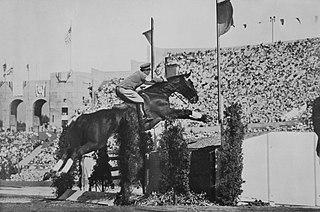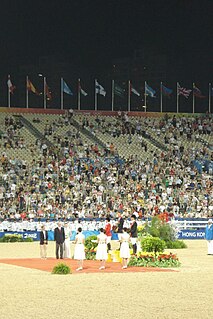The individual eventing event, part of the equestrian program at the 2004 Summer Olympics, was held from 15 to 18 August 2004 in the Olympic Equestrian Centre on the outskirts of Markopoulo in the Attica region of Greece. Like all other equestrian events, the eventing competition was mixed gender, with both male and female athletes competing in the same division.

The equestrian events at the 1932 Los Angeles Summer Games included dressage, eventing, and show jumping. The competitions were held from 10 to 14 August 1932. Due to the Great Depression, only 31 entries from 6 nations competed—which was to be the lowest participation of any Olympic Games.
The equestrian events at the 1972 Summer Olympics in Munich included show jumping, dressage and eventing. All three disciplines had both individual and team competitions. The equestrian competitions were held at 3 sites: an existing equestrian facility at Riem for the individual show jumping and eventing competitions, the Olympic Stadium in Munich for the Nations Cup, and Nymphenburg, a Baroque palace garden, for the sold-out dressage. 179 entries, including 31 women, competed from 27 countries: Argentina, Australia, Austria, Belgium, Bolivia, Bulgaria, Brazil, Canada, Chile, Denmark, German Democratic Republic (GDR), France, Federal Republic of Germany (FRG), Great Britain, Hungary, Ireland, Italy, Japan, Mexico, the Netherlands, Poland, Portugal, Soviet Union, Spain, Sweden, Switzerland, and the USA. The youngest participant was Kurt Maeder from Switzerland at 19 years old, while the oldest rider was Lorna Johnstone from Great Britain at 70 years old.

Equestrianism made its Summer Olympics debut at the 1900 Summer Olympics in Paris, France. It did not return until 1912, but has been featured at every Summer Olympic Games since. The current Olympic equestrian disciplines are Dressage, Eventing, and Jumping. In each discipline, both individual and team medals are awarded. Women and men compete together on equal terms.

The individual eventing at the 2008 Summer Olympics took place between August 9 and 12 2008 at the Hong Kong Sports Institute.
The equestrian events at the 2012 Olympic Games in London were held between 28 July and 9 August at Greenwich Park. Medals were awarded in three disciplines for both individual and team competitions.
The individual eventing event, part of the equestrian program at the 2000 Summer Olympics, was held from 20 to 22 September 2000 in the Sydney International Equestrian Centre. Like all other equestrian events, the eventing competition was mixed gender, with both male and female athletes competing in the same division.
The equestrian events at the 2020 Summer Olympics in Tokyo featured three disciplines for both individual and team competitions.
The individual eventing event, part of the equestrian program at the 1996 Summer Olympics, was held from 23 to 26 July 1996 in the Georgia International Horse Park, in Conyers, Georgia. Like all other equestrian events, the eventing competition was mixed gender, with both male and female athletes competing in the same division.
The individual eventing competition of the equestrian events at the 2015 Pan American Games took place July 17–19 at the Caledon Equestrian Park. The cross-country portion of eventing took place at nearby Will O' Wind Farm, which is located in Mono. The eventers complete a 3-star level dressage test, stadium, and cross-country course. Eventing consisted of three phases: dressage, cross-country, and show-jumping. Scores from each phase were converted into penalty points, which were summed to give a score. For each rider, the best three scores in each phase counted towards the final score. In the dressage portion, the pair performed in front of three judges. The judges gave marks of between 0 and 10 for each of ten required elements; the scores for the judges were averaged to give a score between 0 and 100. That score was then subtracted from 100 and multiplied by 1.5 to give the number of penalty points.
The team eventing competition of the equestrian events at the 2015 Pan American Games took place July 17–19 at the Caledon Equestrian Park. The cross-country portion of eventing took place at nearby Will O' Wind Farm, which is located in Mono.

The team eventing in equestrian at the 1932 Summer Olympics in Los Angeles was held at the Riviera Country Club (dressage), a specially built course in Westchester (cross-country), and the Olympic Stadium (jumping) from 10 to 13 August. NOCs were limited to three horse and rider pairs.

The individual show jumping in equestrian at the 1932 Summer Olympics in Los Angeles was held on 14 August. The event was called the "Prix des Nations" at the time. There were 14 competitors from 4 nations.
The team eventing in equestrian at the 1936 Olympic Games in Berlin was held on the May Field (dressage), in Döberitz (cross-country), and at the Olympiastadion (jumping) from 13 to 16 August. Scores from the individual competition were used to determine team results. Any nation with three individual horse and rider pairs was entered as a team, with team score being the sum of the three individual scores. All three pairs had to finish the event for the team to receive a place, however; this eliminated 10 out of the 14 teams.

The individual eventing in equestrian at the 1956 Olympic Games in Helsinki was held from 30 July to 2 August. Only 34 of the 59 starters were able to finish the competition, with 20 being disqualified in the cross-country, 3 more retiring during that phase, and 2 being disqualified in the jumping.

The team eventing in equestrian at the 1952 Olympic Games in Helsinki was held from 30 July to 2 August. Only 33 of the 57 starters were able to finish the competition, with 19 being disqualified in the cross-country, 3 more retiring during that phase, and 2 being disqualified in the jumping. This left only 6 of the 19 teams with all three riders finishing.
The individual eventing at the 1960 Summer Olympics took place between 6 and 10 September. Eventing was open to men only. It was the 10th appearance of the event.
The team eventing at the 1960 Summer Olympics took place between 6 and 10 September. Eventing was open to men only. It was the 10th appearance of the event.
The team eventing at the 1976 Summer Olympics took place between 23 and 25 July. The event was open to men and women. The competition included three segments: dressage, cross-country, and show-jumping. Penalties from each were summed to give a total score. Scores from the top 3 horse and rider pairs for each nation were summed to give a team score; the lowest pair's score was dropped. Teams without at least 3 finishing pairs were not given a final score.
The team eventing at the 1980 Summer Olympics took place between 25 and 27 July. The event was open to men and women. The competition included three segments: dressage, cross-country, and show-jumping. Penalties from each were summed to give a total score. Scores from the top 3 horse and rider pairs for each nation were summed to give a team score; the lowest pair's score was dropped. Teams without at least 3 finishing pairs were not given a final score.






